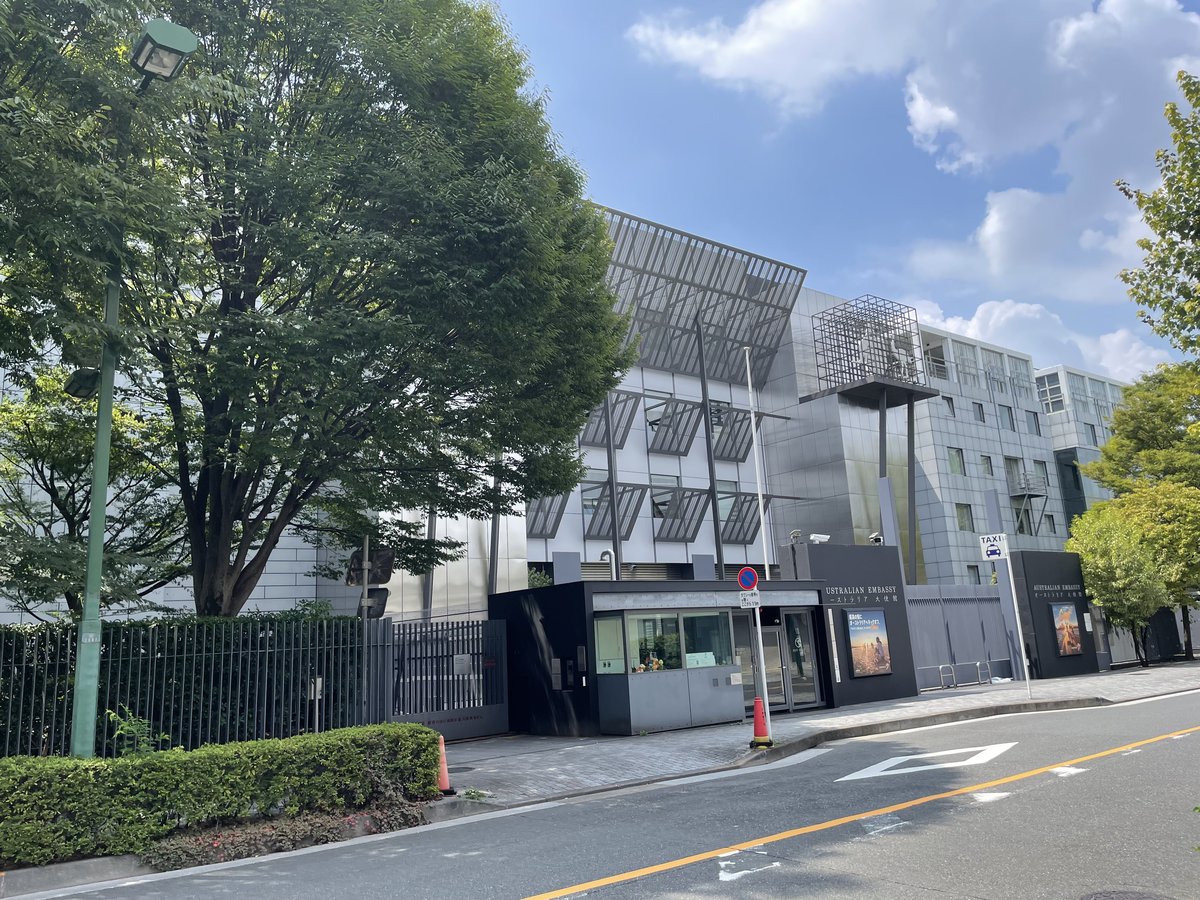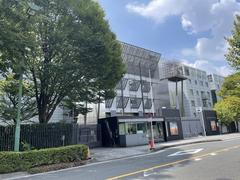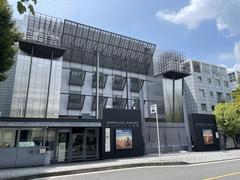
Australian Embassy Tokyo: Visiting Hours, Tickets, and Travel Guide
Date: 14/06/2025
Introduction
The Australian Embassy in Tokyo is a distinguished diplomatic and cultural landmark, reflecting over seven decades of strong Australia–Japan relations. Located in the historic Mita district of Minato Ward, the embassy stands on grounds once owned by eminent Japanese feudal families, embodying a blend of heritage, architectural innovation, and the vibrant partnership between the two nations. This guide offers detailed information on the embassy’s history, architecture, visitor access, consular services, and surrounding attractions—ensuring a rewarding experience for both travelers and those in need of consular support.
For the most current updates and official guidelines, consult the Australian Embassy Tokyo Official Website and reference materials such as ANU Press.
Table of Contents
- Introduction
- Historical Overview
- Architectural Significance
- Visiting Information
- Cultural Engagement and Special Events
- Nearby Attractions and Travel Tips
- Frequently Asked Questions (FAQs)
- References and Further Reading
Historical Overview
Origins and Site Legacy
The embassy occupies a site rich in Japanese history, with its origins as the Edo-period residence of the Shimazu and later the Hachisuka families—daimyō from Kyushu and Awa respectively. After the 1923 Great Kanto Earthquake destroyed the original structures, an English-style mansion was constructed, later acquired by the Australian government in 1951 (ANU Press). This acquisition marked the formalization of Australia’s diplomatic presence in postwar Japan, with the mission being elevated to embassy status in 1952.
Diplomatic Evolution
From its early days as both chancery and ambassador’s residence, the Tokyo embassy has been a focal point for bilateral cooperation, trade negotiations, and cultural exchange. Over time, the embassy’s role has expanded, notably during major events such as the 2011 Tohoku earthquake, when staff coordinated consular support and humanitarian aid (ANU Press).
Architectural Significance
Redevelopment and Design
By the late 1980s, the need for a modern, secure complex led to a major redevelopment. The original mansion was demolished and replaced by a purpose-built embassy designed by Denton Corker Marshall, completed in 1990 (press-files.anu.edu.au). The architecture harmonizes Australian openness with Japanese attention to context and detail, using robust materials to meet strict seismic and security standards.
Features and Symbolism
- Security & Practicality: Bullet-resistant glass, laser-proofing, and earthquake-resistant construction reflect both functional and symbolic resilience.
- Gardens: Landscaped grounds blend Australian and Japanese botanical traditions, offering tranquil green spaces within urban Tokyo.
- Visual Identity: The embassy’s hilltop location and illuminated entryway underscore its diplomatic stature and welcoming ethos.
- Cultural Spaces: Interior areas display Australian art and host cultural events, reinforcing the embassy’s multifaceted role.
Visiting Information
Hours and Access
- Business Hours: Monday–Friday, 9:00 AM–5:00 PM (excluding Japanese and Australian public holidays)
- Consular Office: 9:00–12:30 and 13:30–17:00 (official hours)
- Location: 2-1-14 Mita, Minato-ku, Tokyo 108-8361
- Nearest Stations: Mita Station (Toei Asakusa/Mita Lines), Tamachi Station (JR Yamanote/Keihin-Tohoku Lines)
Appointments and Entry Requirements
- Appointments: Mandatory for notarial and passport services. Book online via the consular booking system.
- Identification: Bring valid photo ID (passport or Japanese residence card).
- Security Screening: All visitors undergo bag checks and metal detection.
Consular and Notarial Services
- Services Include: Passport applications/renewals, notarial acts (certified copies, affidavits, statutory declarations), Certificates of No Impediment to Marriage, and driver’s license support.
- Fees: Payable by credit card or Japanese yen; check the consular services page for details.
- Visa Services: Not processed at the embassy; refer to the visa information page for guidance.
Accessibility
The embassy is fully accessible, with wheelchair ramps, elevators, accessible restrooms, and a nursing room for families. Contact staff in advance for additional support.
Security Procedures
Arrive at least 15 minutes early for security checks. Photography is prohibited inside the compound; exterior and garden photos are permitted with staff approval.
Cultural Engagement and Special Events
While regular public tours are not available, the embassy hosts open days, art exhibitions, and cultural events celebrating Australian heritage and bilateral milestones. These programs are usually advertised via the embassy’s news page or Facebook page.
Photographic opportunities are best in the embassy’s gardens and around the historic ambassador’s residence. For event participation, advance registration may be required.
Nearby Attractions and Travel Tips
The Mita district offers convenient access to several Tokyo landmarks:
- Tokyo Tower: An iconic observation structure with panoramic city views.
- Zojoji Temple: A historic Buddhist temple with beautiful gardens.
- Hamarikyu Gardens: Edo-period landscape gardens, ideal for relaxation.
For easy travel, use a Suica or Pasmo card on the Tokyo Metro. Combine your embassy visit with exploration of these nearby sites to enhance your cultural experience.
Frequently Asked Questions (FAQs)
Q: What are the embassy’s visiting hours?
A: Monday–Friday, 9:00 AM–5:00 PM for general business; consular services from 9:00–12:30 and 13:30–17:00.
Q: Do I need an appointment for consular services?
A: Yes, appointments are mandatory for notarial and passport services.
Q: Can I tour the embassy?
A: Public tours are not offered, but cultural events are occasionally open to registered guests.
Q: Is the embassy accessible for visitors with disabilities?
A: Yes, all public areas are accessible.
Q: Is photography allowed?
A: Only in exterior and garden areas, with staff permission.
Q: Does the embassy process visas?
A: No, visa and immigration matters are managed by the Department of Home Affairs; see the official information page.
References and Further Reading
- Australian Embassy Tokyo Official Website
- ANU Press Source
- Architectural History - ANU Press
- Embassies.info: Australian Embassy in Tokyo
- Tokyo Metro Official Site
- Smartraveller Japan page
- Consular Booking System
- Visa Information
- Australian Embassy Tokyo Location and Access
Final Tips
To ensure a smooth visit:
- Book appointments early, especially during peak seasons.
- Arrive ahead of time for security.
- Check for cultural events on the official website.
- Use the Audiala app for real-time updates, event notifications, and local travel tips.
The Australian Embassy Tokyo stands as a testament to the enduring relationship between Australia and Japan, offering a welcoming environment for official business and cultural exchange. Whether you seek consular assistance or are interested in the site’s history and architecture, your visit promises both practical support and cultural enrichment.































































































































































































































